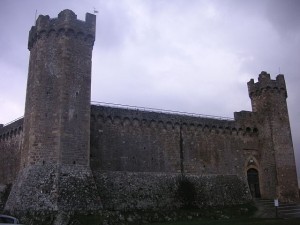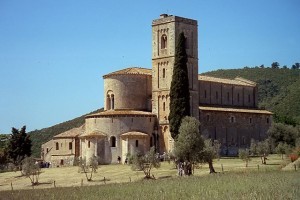Holidays in Tuscany: Val D’orcia
Intense, warm and balanced, just like a glass of Brunello di Montalcino, Val Dorcia will surely win your heart. The visits to the wine bars are probably the most popular attractions in this area. However, during your holiday in Tuscany, you will find out that there is much more.
Val d’Orcia is a picturesque region of Tuscany part of UNESCO World Heritage along with the town of Pienza, located on the Northeast end of the valley. Its landscape is made of cultivated fields and green hills with little medieval citadels and abbeys on the top.
The Via Francigena, the pilgrims’ way that crosses Val d’Elsa, continues in the Val d’Orcia, connecting the little hamlets of the valley.
What to see
Montalcino. Famous all over the world for its wine, the Brunello, Montalcino is a fortified medieval town that lies on the top of a hill, surrounded by vineyards and  farms. The main activity to enjoy around here is a tour of the wineries, of course, but a tour of the town isn’t to rule out. Pay a visit to the Fortezza: the core of this majestic building dates back to the 14th century, but the fortress has been enlarged when Medici extended their dominion over the town. From its yard you can enjoy a wonderful view of the valley, but if that’s not enough you can buy a ticket to visit its bastions and take a look from up there.
farms. The main activity to enjoy around here is a tour of the wineries, of course, but a tour of the town isn’t to rule out. Pay a visit to the Fortezza: the core of this majestic building dates back to the 14th century, but the fortress has been enlarged when Medici extended their dominion over the town. From its yard you can enjoy a wonderful view of the valley, but if that’s not enough you can buy a ticket to visit its bastions and take a look from up there.
Before leaving, stop at the Saint Augustine church to visit the Museo d’Arte Sacra, where the Madonna col Bambino by Simone Martini is on exhibit.
The surroundings of Montalcino will be Disneyland of wine lovers, stop by any of the wineries to have a glass of Brunello, but if you’re not satisfied yet you can go to the Brunello museum, located South of the town on the way to Sant’Antimo abbey.
Pienza. The old town of Pienza, part of UNESCO World Heritage, is one of the most famous sights of Italy, and that’s why during the weekends the town is crowded with tourists: given its small extension you’ll feel just as you were right in the middle of Florence. Pienza is the quintessential Renaissance town, renovated by the principles of fifteenth-century architecture by the will of the pope Pio II. The central square, named after Pio II himself, has been designed by Bernardo Rossellino, according to the standards outlined by his mentor Leon Battista Alberti. Here are the main buildings of the old town, all built in a short span of time, just three years between the 1459 and the 1462. The Duomo replaced the Romanesque church of Saint Mary and a papal bull prevented any future changes to the building, which today looks exactly the way it did on its inauguration day. On the side of the church are the Palazzo Vescovile, enlarged in 1492 by the will of cardinal Borgia, soon to become pope Alexander IV, and Palazzo Piccolomini, the true masterpiece among Rossellino’s works. Palazzo Piccolomini has been the residence of the pope Pio II: its garden is enchanting, while you can visit the papal apartments joining one of the guided tours that start from the main entrance every 30 minutes.
A tour of the abbeys
The enchanting landscape of Val d’Orcia wouldn’t simply be the same without the silhouettes of the medieval abbeys on the hills. If you’re in the area you must absolutely pay a visit to at least a couple of them.
Sant’Antimo Abbey. This charming Romanesque abbey is located in the middle of an isolated valley 10 km away from Montalcino. The best time to pay a visit is  surely in the morning, when the sunlight coming through the windows creates a magical atmosphere. You can get there in a couple of hours from Montalcino if you feel like walking, or you can take a bus (there are 3 or 4 rides a day). Many decide to reach the abbey on foot, stop at Locanda Sant’Antimo in the near town of Castelnuovo dell’Abate, to taste some authentic Tuscan dish, and then go back to Montalcino by bus.
surely in the morning, when the sunlight coming through the windows creates a magical atmosphere. You can get there in a couple of hours from Montalcino if you feel like walking, or you can take a bus (there are 3 or 4 rides a day). Many decide to reach the abbey on foot, stop at Locanda Sant’Antimo in the near town of Castelnuovo dell’Abate, to taste some authentic Tuscan dish, and then go back to Montalcino by bus.
San Salvatore Abbey. The town of Abbadia San Salvatore is located on the Southernmost point of Val d’Orcia, right beneath Monte Amiata and surrounded by chestnut groves. Here, in the middle of the old town, rises the abbey of San Salvatore. Its Romanesque church dates back to the 11th century, and it’s been renovated then in the 16th. The building hides a suggestive and vast Longobardic crypt: the town was founded indeed in the 743 DC by the Longobardic leader Erfone.
Where to eat
Osticcio (Montalcino, Via Matteotti 23). A vast selection of Brunello di Montalcino, and of the lesser famous Rosso di Montalcino, is available in this traditional Tuscan osteria. Drink the wine while eating a selection of local cured meats and cheese, or one of the traditional dishes of the menu: you won’t be let down!
Ristorante di Poggio Antico (Montalcino). If you’re in Val d’Orcia you have to visit at least one vineyard, and if you don’t know which one you should pick the one of Poggio Antico. In this farm/winery you’ll have the chance to join a tasting session as well as have dinner at its restaurant, one of the most famous of Tuscany. Taste a glass of Brunello di Montalcino of course but try also their Madre IGT, a real treat. Poggio Antico is 4,5km away from Montalcino on the road to Grosseto.
Osteria La Porta (Monticchiello, Via del Piano 3). This wonderful osteria is located in Monticchiello, a charming hamlet 15 minutes away from Pienza by car. This place is at the same time a trattoria, a wine shop and a cafe, and it’s one of the most known of the whole Val d’Orcia (you might want to place a reservation). Even when it’s not lunch or dinner time you can always stop by for a snack, a bruschetta or a selection of local cheese, and a glass of wine of course.






